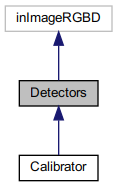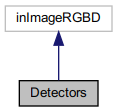Layered detector part of puzzle scene perceiver grouping. More...


Public Member Functions | |
| def | __init__ (self, detCfg=None, detInst=None, processors=None) |
| Constructor for layered puzzle scene detector. More... | |
| def | adapt (self) |
| Adapt the layer detection models. More... | |
| def | correct (self) |
| Apply correction process to the individual detectors. More... | |
| def | detect (self, I) |
| Apply predict, measure, correct process to source image. More... | |
| def | emptyDebug (self) |
| def | emptyState (self) |
| Get and empty state to recover its basic structure. More... | |
| def | getDebug (self) |
| def | getState (self) |
| Get the complete detector state, which involves the states of the individual layer detectors. More... | |
| def | info (self) |
| def | loadFrom (fPtr) |
| def | measure (self, I) |
| Apply detection to the source image pass. More... | |
| def | predict (self) |
| Generate prediction of expected measurement. More... | |
| def | process (self, I) |
| Apply entire predict to adapt process to source image. More... | |
| def | saveTo (self, fPtr) |
| Save the instantiated Detector to given HDF5 file. More... | |
Static Public Member Functions | |
| def | buildFromCfg (theConfig) |
| Instantiate from stored configuration file (YAML). More... | |
| def | calibrate2config (theStream, outFile) |
| def | load (inFile) |
Public Attributes | |
| depth | |
| glove | |
| imGlove | |
| First, perform any specified pre-processing. More... | |
| imPuzzle | |
| mask | |
| workspace | |
Detailed Description
Layered detector part of puzzle scene perceiver grouping.
Requires RGBD input stream.
Constructor & Destructor Documentation
◆ __init__()
| def __init__ | ( | self, | |
detCfg = None, |
|||
detInst = None, |
|||
processors = None |
|||
| ) |
Constructor for layered puzzle scene detector.
- Parameters
-
[in] detCfg Detector configuration. [in] processors Image processors for the different layers. [in] detInst Detection instances for the different layers.
Reimplemented in Calibrator.
Member Function Documentation
◆ adapt()
| def adapt | ( | self | ) |
Adapt the layer detection models.
This part is tricky as there may be dependencies across the layers in terms of what should be updated and what should not be. Applying simple filtering to establish what pixels should adapt and which ones shouldn't.
Reimplemented in Calibrator.
◆ buildFromCfg()
|
static |
Instantiate from stored configuration file (YAML).
◆ calibrate2config()
|
static |
◆ correct()
| def correct | ( | self | ) |
Apply correction process to the individual detectors.
Apply naive correction on a per detector basis. As a layered system, there might be interdependencies that would impact the correction step. Ignoring that for now since it does not immediately come to mind what needs to be done.
Reimplemented in Calibrator.
◆ detect()
| def detect | ( | self, | |
| I | |||
| ) |
Apply predict, measure, correct process to source image.
Running detect alone elects not to adapt or update the underlying models. The static model is presumed to be sufficient and applied to the RGBD stream.
- Parameters
-
[in] I Source RGB-D image (structure/dataclass).
Reimplemented in Calibrator.
◆ emptyDebug()
| def emptyDebug | ( | self | ) |
Reimplemented in Calibrator.
◆ emptyState()
| def emptyState | ( | self | ) |
Get and empty state to recover its basic structure.
- Parameters
-
[out] estate The empty state.
Reimplemented in Calibrator.
◆ getDebug()
| def getDebug | ( | self | ) |
Reimplemented in Calibrator.
◆ getState()
| def getState | ( | self | ) |
Get the complete detector state, which involves the states of the individual layer detectors.
- Parameters
-
[out] state The detector state for each layer, by layer.
Reimplemented in Calibrator.
◆ info()
| def info | ( | self | ) |
Reimplemented in Calibrator.
◆ load()
|
static |
◆ loadFrom()
| def loadFrom | ( | fPtr | ) |
◆ measure()
| def measure | ( | self, | |
| I | |||
| ) |
Apply detection to the source image pass.
- Parameters
-
[in] I An RGB-D image (structure/dataclass).
Reimplemented in Calibrator.
◆ predict()
| def predict | ( | self | ) |
Generate prediction of expected measurement.
The detectors are mostly going to be static models, which means that prediction does nothing. Just in case though, the prediction methods are called for them.
Reimplemented in Calibrator.
◆ process()
| def process | ( | self, | |
| I | |||
| ) |
Apply entire predict to adapt process to source image.
- Parameters
-
[in] I Source RGB-D image (structure/dataclass).
Reimplemented in Calibrator.
◆ saveTo()
| def saveTo | ( | self, | |
| fPtr | |||
| ) |
Save the instantiated Detector to given HDF5 file.
The save process saves the necessary information to re-instantiate a Detectors class object.
- Parameters
-
[in] fPtr An HDF5 file point.
Reimplemented in Calibrator.
Member Data Documentation
◆ depth
| depth |
◆ glove
| glove |
◆ imGlove
| imGlove |
First, perform any specified pre-processing.
- Note
- Not dealing with pre-processor, but it might be important.
- Todo:
- Figure out how to use the improcessor.
Second, invoke the layer detectors and post-processor to differentiate the actual semantic layers of the scene. The layer detectors should be considered as raw detectors that need further polishing to extract the desired semantic layer information. These layers are further processed by customized track pointers and filters. The post processing here is hard-coded rather than a private member function invocation.
Shrink region associated to the surface just to clean up potential sources of confusion and promote recovery of puzzle pieces that are fully captured. Package the processed layers started with the glove. Next, remove any parts of the not surface layer that intersect with the expanded glove region. May remove adjacent puzzle piece area; that's OK since we can't rely on those pieces having been fully measured/captured. After that
◆ imPuzzle
| imPuzzle |
◆ mask
| mask |
◆ workspace
| workspace |
The documentation for this class was generated from the following file:
- /home/pvela/python/surveillance/Surveillance/layers/PuzzleScene.py
 1.8.17
1.8.17